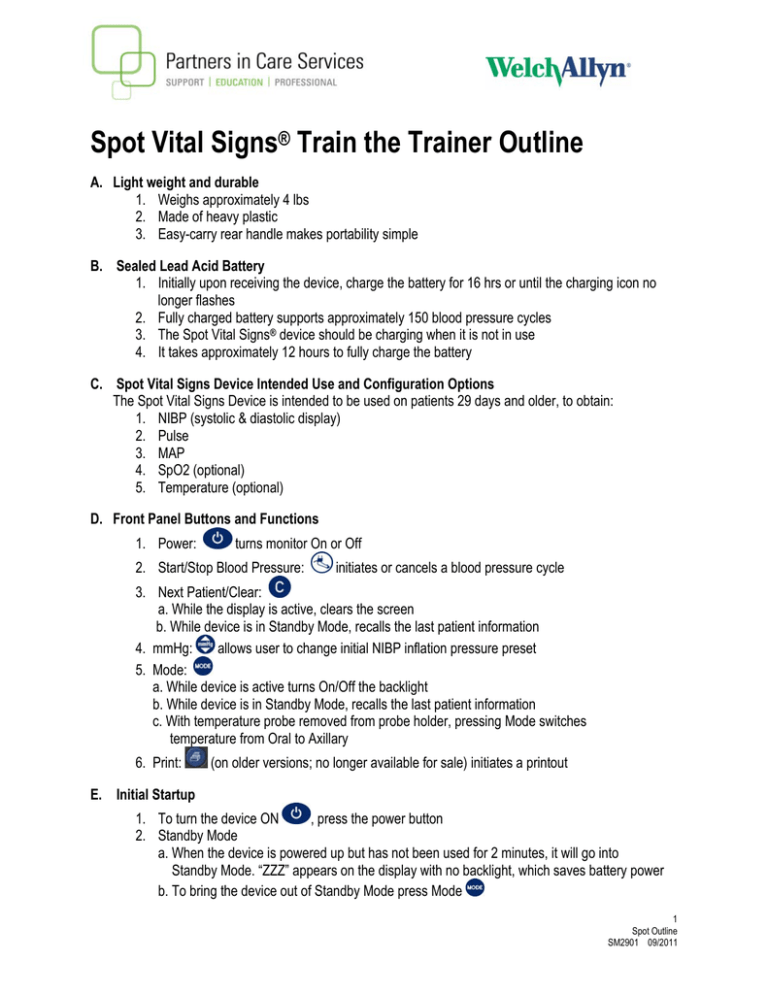Spot Vital Signs® Train the Trainer Outline
advertisement

Spot Vital Signs® Train the Trainer Outline A. Light weight and durable 1. Weighs approximately 4 lbs 2. Made of heavy plastic 3. Easy-carry rear handle makes portability simple B. Sealed Lead Acid Battery 1. Initially upon receiving the device, charge the battery for 16 hrs or until the charging icon no longer flashes 2. Fully charged battery supports approximately 150 blood pressure cycles 3. The Spot Vital Signs® device should be charging when it is not in use 4. It takes approximately 12 hours to fully charge the battery C. Spot Vital Signs Device Intended Use and Configuration Options The Spot Vital Signs Device is intended to be used on patients 29 days and older, to obtain: 1. NIBP (systolic & diastolic display) 2. Pulse 3. MAP 4. SpO2 (optional) 5. Temperature (optional) D. Front Panel Buttons and Functions 1. Power: turns monitor On or Off 2. Start/Stop Blood Pressure: initiates or cancels a blood pressure cycle 3. Next Patient/Clear: a. While the display is active, clears the screen b. While device is in Standby Mode, recalls the last patient information 4. mmHg: allows user to change initial NIBP inflation pressure preset 5. Mode: a. While device is active turns On/Off the backlight b. While device is in Standby Mode, recalls the last patient information c. With temperature probe removed from probe holder, pressing Mode switches temperature from Oral to Axillary 6. Print: (on older versions; no longer available for sale) initiates a printout E. Initial Startup , press the power button 1. To turn the device ON 2. Standby Mode a. When the device is powered up but has not been used for 2 minutes, it will go into Standby Mode. “ZZZ” appears on the display with no backlight, which saves battery power b. To bring the device out of Standby Mode press Mode 1 Spot Outline SM2901 09/2011 3. Before taking a NIBP measurement, always perform the following: a. Select appropriate cuff. The cuff is the appropriate size when the artery index marker lies between the range markings on the NIBP cuff b. Position the cuff on a bare arm, midway between the shoulder and the elbow, with the artery index marker over the brachial artery. It should fit comfortably to allow one to two finger spaces between the cuff and the arm. The cuffed upper arm should rest at heart level during the measurement and the patient should remain quiet and have no movement to the arm NOTE: If the cuff is not level with the heart, subtract 1.8 mmHg to the displayed reading for each inch of elevation above the heart, or add 1.8 mmHg from the displayed reading for each inch arm is below the heart. F. To start a NIBP cycle 1. Press Start/Stop button . The cuff inflates to 160 mmHg as a factory default. 2. The blood pressure reading is displayed for 2 minutes, then disappears. Press Mode to recall the last reading 3. To change the NIBP pressure preset factory default settings, follow these steps: a. Press mmHg for half second to scroll the target NIBP inflation pressure options b. Keep pressing mmHg (160 mmHg, 140 mmHg, 120 mmHg, 200 mmHg, 180 mmHg) c. Once target inflation pressure is displayed, press Start/Stop button d. Target inflation pressure returns to Internal Configuration setting (Factory default is 160 mmHg) after blood pressure reading has been obtained or device is turned off G. Pulse 1. Pulse rate readings are measured from SpO2. If SpO2 is not available pulse rate will be measured from the NIBP reading H. MAP 1. MAP can be turned on or off by entering the internal configuration mode a. Turn the Spot device Off b. Press both POWER and START/STOP simultaneously. The device will power on in the internal configuration mode c. Press Mode button to cycle through the menu to the MAP option screen d. Press START/ STOP or NEXT PATIENT/ CLEAR button to turn MAP On or Off e. When the desired functionality is displayed, turn the device off. I. Sp02 ( if applicable) 1. Insert the patient’s index finger completely into the sensor. The thumb is not recommended for use with the finger clip sensor. NOTE: If blood pressure measurement is occurring simultaneously, ensure that the finger clip sensor is attached to the limb opposite the limb with the B/P cuff 2. The pulse signal bar illuminates indicating the relative strength and quality of the patient’s pulses at the sensor site 2 Spot Outline SM2901 09/2011 1. The sensor takes approximately 10 seconds to determine initial SpO2 value and updates the reading every second. The Spot Vital Signs device will display the SpO2 continuously for up to 10 minutes. After 10 minutes the device displays an error code. J. Temperature (if applicable) 1. The Spot Vital Signs device can be used to take oral temperatures in approximately 4 seconds, axillary temperatures in approximately15 seconds, and rectal temperatures in approximately 10 seconds 2. The Spot Vital Sign device can display temperature in degrees Fahrenheit (°F) or Celsius (°C). To determine the current temperature scale, remove the temperature probe from its holder and view °F or °C on the display 3. To change the display from °F to °C you must enter the configuration mode. a. Turn the Spot Vital Signs device Off b. Press the POWER and the START/STOP button simultaneously. The device will power on in the internal configuration mode c. Press Mode button to cycle through the menu to the Temperature option screen d. The first option illuminated on the temperature display is °F; press NEXT PATIENT/CLEAR button to illuminate e. When the desired temperature scale is selected, turn the device Off f. When the device is turned on again, the new temperature scale is the default 1. Taking an Oral Temperature a. Ensure that the probe with the BLUE ejection button is connected to the device b. Remove the probe from the probe well. A short self test is initiated and the screen will display “OrL” c. Once the “OrL” is displayed load a probe cover onto the probe by holding the probe collar with the thumb and forefinger d. Place the probe deep into the patient’s sublingual pocket e. Hold the probe in place maintaining tissue contact until the temperature is complete. Instruct the patient not to talk or move during the temperature reading process f. When the final temperature is reached, a beep sounds and the temperature is displayed. It will remain on the screen for 2 minutes g. After the temperature measurement is complete, remove the probe from the patient’s mouth and remove the probe cover by firmly pressing on the ejection button on the probe. NOTE: Do not re-use probe covers. 3 Spot Outline SM2901 09/2011 5. Taking an Axillary Temperature NOTE: Normal mode axillary temperatures are FDA approved for children under the age of 4 years. If an axillary reading is desired for a patient 4 years and older, use the oral probe in Monitor mode. a. Ensure that the probe with the BLUE ejection button is connected to the unit. b. Remove the probe from the probe well. A short self test is initiated and the screen will display “OrL” c. Press MODE to change display from “OrL’ to “ALY” for an axillary temperature d. Load a probe cover onto the probe e. Avoid folds in the axilla and place probe tip vertically as high as you can as shown. TIP: Align the probe vertically with the spine f. Place the arm at the patient’s side. Hold in this position without movement of the arm or probe during the measurement cycle g. When the final temperature is reached, a beep sounds and the temperature is displayed. It will remain on the screen for 2 minutes h. To take an axillary temperature in monitor mode, follow steps 5a through 5g plus: i. Leave the probe in place and press the Mode button. An “M” appears on the temperature display to indicate Monitor mode ii. Maintain probe tissue contact for at least 5 minutes iii. Record the monitor mode temperature before placing the probe back in the probe holder. The Spot Vital Signs device does not save the Monitor mode temperature 6. Taking a Rectal Temperature a. Ensure that the rectal probe with the RED ejection button is connected to the Spot Vital Signs device b. Remove the probe from the probe well. A short self test is initiated and the screen will display “Rec” indicating the rectal probe in use c. Once “Rec” is displayed, load the probe cover onto the probe by holding the probe collar with the thumb and forefinger. Apply lubricant if desired d. Separate the buttocks and gently insert the probe into the rectum ONLY 1.5 cm (5/8 of an inch for adults), and LESS for infants and children e. Hold the probe in place for the entire temperature. This should take approximately 10 seconds for a reading f. After the temperature process is finished, eject the probe cover and dispose of properly 4 Spot Outline SM2901 09/2011 7. Monitor Mode Temperatures a. May be taken in Oral, Axillary, or Rectal routes by the following the steps discussed in Section J, 5h b. To obtain accurate Monitor mode temperatures, you must maintain probe contact with tissue at the various sites as listed: i. Oral: 3 minutes ii. Axillary: 5 minutes iii. Rectal: 3 minutes K. Error Codes 1. Refer to the Directions for Use for a list of possible Error Codes which provides a description and probable cause of each. L. Cleaning 1. Clean the Spot Vital Signs with a cloth slightly dampened with warm water and a mild detergent solution. Never immerse the device in any type of fluid. Other solutions that can be used are: a. a diluted non-staining disinfectant b. 70% isopropyl alcohol c. 10% chlorine bleach solution d. mild detergent in water 5 Spot Outline SM2901 09/2011




